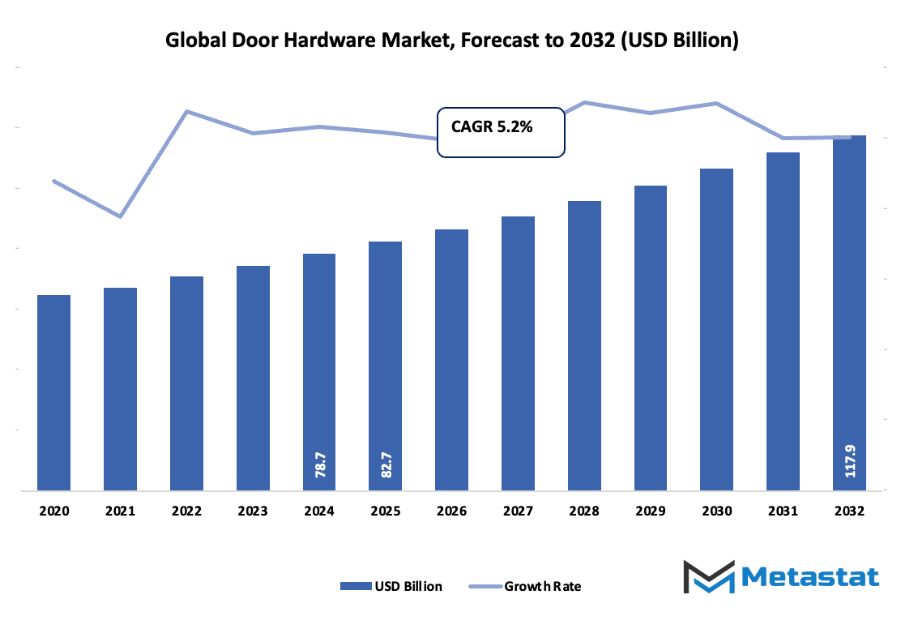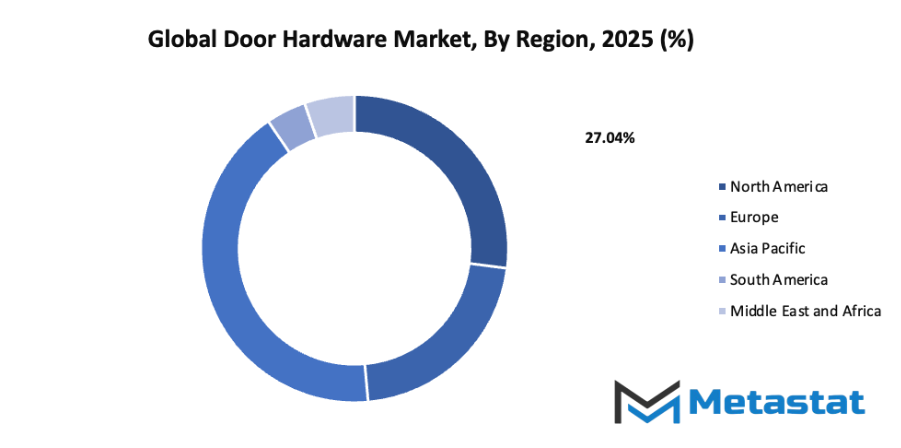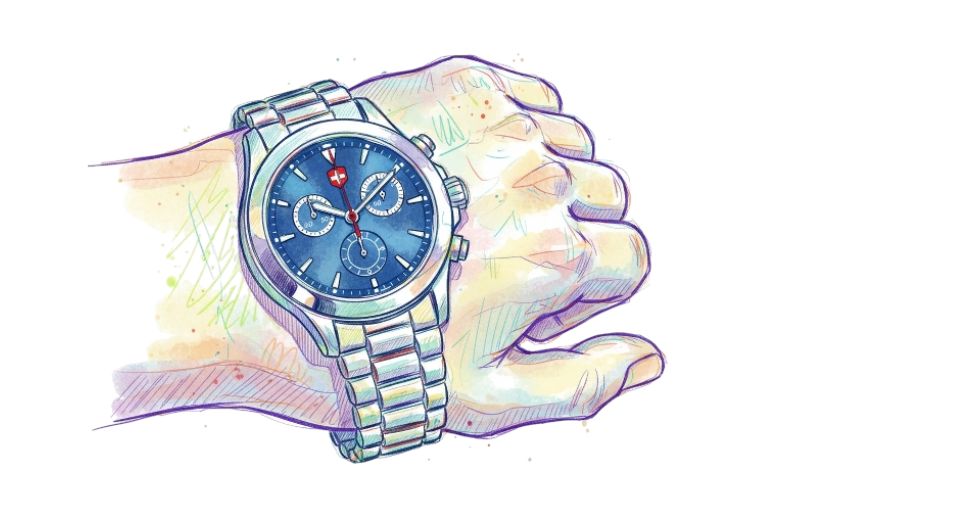Global Door Hardware Market - Comprehensive Data-Driven Market Analysis & Strategic Outlook
The World Door Hardware market and industry will follow a path that started with basic mechanical advancements centuries ago and gradually evolved into a highly advanced system of goods and solutions for both residential and commercial use. In the beginning, door hardware used to be mainly functional, and craftsmen would make locks, handles, and hinges that offered security as well as durability. With the industrial revolution, the mass production of metals made door hardware more standardized and easier to access, the first huge milestone that set the tone for the direction of the global door hardware market.
- Global door hardware market worth about USD 82.7 Billion in 2025 at a growth rate of about 5.2% during the forecast period of 2032, with the potential of reaching more than USD 117.9 Billion.
- Locks hold close to 37.7% market share, fueling innovation and burgeoning applications with aggressive research.
- Major trends fueling growth: Increasing demand for sophisticated security and access control solutions, Increasing construction and real estate development in residential and commercial spaces
- Opportunities include: Rising adoption of smart and IoT-integrated door hardware solutions
- Key insight: The market will grow exponentially in value over the course of the next decade, exposing notable growth opportunities.

As the twentieth century continued, evolving architectural designs and customer expectations began to get reflected in product designs. Aesthetic yet functional handles, locks, and sliding mechanisms became popular, reflecting a transformation in people's perception of door hardware not just as a utility but as a component that augments interior style. In the mid-1900s, regulatory policies in relation to safety, fire codes, and access control began to surface, compelling manufacturers to think beyond conventional designs. The rules set the stage for the industry to transition towards a more differentiated and compliant range of products. Advances in technology went on to redefine the scenario. Electronic locks, smart access control systems, and biometric verification devices started remodeling the security and convenience benchmarks.
Consumer attitudes, more shaped by digital connectivity and a need for smooth integration, will increasingly challenge manufacturers to develop more intelligent and stylistically versatile solutions. Sustainability issues and material breakthroughs, including corrosion-resistant alloys and environmentally friendly finishes, will also come to the fore, echoing larger societal drivers that will shape design and production choices. Major developments in the worldwide door hardware sector will be from the conventional mechanical systems to electronic and intelligent ones, adherence to global safety and environmental standards, and continued evolution with changing customer needs. Through following its path from utilitarian beginnings to its present-day complex nature, it is apparent that this sector will keep evolving with technology, aesthetics, and customer needs crossing paths, eventually determining the doors and portals of the future.
Market Segments
The global door hardware market is mainly classified based on Type, Material, Application.
By Type is further segmented into:
- Locks: Locks will remain a core area of the global door hardware market as security and safety requirements increase in every industry. Technological advancements will make them more robust and user-friendly. Designs of the future will feature integrated intelligent locking systems that are convenient but still have high security, which will appeal to both residential and commercial consumers.
- Handles: Handles will continue to play a crucial role in the global door hardware market, with designs adapting to fit with design trends and ergonomic requirements. Materials and finishes will enhance wear resistance, and creative designs will find favour in contemporary architectural designs. Integration of smart handles with access control will also enhance their significance.
- Hinges: Hinges will undergo great innovation in the international Door Hardware market. Long-lasting materials and smoother mechanisms will be the norm, enabling heavier and larger doors. The future will bring designs emphasizing silent running and long-lasting durability, which will be crucial for both domestic and commercial use.
- Other: Other global door hardware market components will come into the limelight with increased customization and specialized requirements. Accessories like door stoppers, closers, and pivots will be made with durability and ease of use in mind. Emerging technologies will render these additions more functional and visually appealing.
By Material the market is divided into:
- Metal: Metal will remain the market leader in the global door hardware market due to its durability and strength. Advances in the future will be centered around corrosion resistance, lightweight metals, and sleek finishes that go well with modern interiors. Metal hardware will continue to be favoured for industrial and commercial uses due to its lasting performance.
- Wood: Wood will continue to hold its position in the World Door Hardware market for high-end and classic designs. Sophisticated treatments will increase durability and resistance to elements. Customization options and finishes will increase, providing more variations for single-family home and boutique commercial projects.
- Plastic: Plastic will be in demand in the global door hardware market for light and economical solutions. Future growth will emphasize greater strength, improved durability, and eco-friendliness. Plastic hardware will suit frugal projects while being compatible with innovative designs.
- Others: Other materials will gain growing importance in the global door hardware market as the future of innovation unfolds. Hybrid and composite materials will merge strength, beauty, and sustainability. New choices will be offered to residential, commercial, and industrial applications by these materials, responding to the changing needs of contemporary construction.
By Application the market is further divided into:
- Residential: The global door hardware market will be driven by residential applications. Homeowners will demand both security and aesthetic appeal, with a focus on long-lasting, fashionable, and easy-to-use hardware. Integration with smart homes will define trends of the future, and door hardware will become a staple in contemporary living spaces.
- Commercial: Commercial use will increase the global door hardware market as companies emphasize security, efficiency, and aesthetics. Innovations will prioritize durability, reduced maintenance, and flexibility of design to suit different office, retail, and hospitality settings. Upcoming commercial developments will depend on high-performance hardware that enables building functionality.
- Industrial: Industrial uses will expand in the global door hardware market due to the need for factories and warehouses to have strong, reliable, and low-maintenance solutions. Future trends will emphasize corrosion resistance, heavy-duty construction, and compatibility with automation. Hardware will assist safety regulation as well as efficiency of operation within industrial settings.
|
Forecast Period |
2025-2032 |
|
Market Size in 2025 |
$82.7 Billion |
|
Market Size by 2032 |
$117.9 Billion |
|
Growth Rate from 2025 to 2032 |
5.2% |
|
Base Year |
2024 |
|
Regions Covered |
North America, Europe, Asia-Pacific, South America, Middle East & Africa |
By Region:
- Based on geography, the global door hardware market is divided into North America, Europe, Asia-Pacific, South America, and the Middle East & Africa.
- North America is further divided into the U.S., Canada, and Mexico, whereas Europe consists of the UK, Germany, France, Italy, and the Rest of Europe.
- Asia-Pacific is segmented into India, China, Japan, South Korea, and the Rest of Asia-Pacific.
- The South America region includes Brazil, Argentina, and the Rest of South America, while the Middle East & Africa is categorized into GCC Countries, Egypt, South Africa, and the Rest of the Middle East & Africa.

Growth Drivers
- Growing demand for advanced security and access control solutions: Increasing concerns about safety in residential and commercial spaces will drive the adoption of advanced door hardware. Solutions such as electronic locks, biometric systems, and access control devices will become more common. The need for reliable security will push manufacturers to develop innovative products that meet these evolving requirements.
- Rising construction and real estate development across residential and commercial sectors: Expansion in construction and real estate development will support the growth of the global door hardware market. As new residential complexes, office spaces, and commercial properties are built, demand for high-quality door hardware will increase. Developers will focus on integrating durable and modern hardware to meet customer expectations and safety standards.
Challenges and Opportunities
- Fluctuations in raw material costs (steel, aluminum, etc.): Changes in the prices of key materials like steel and aluminum will directly influence production costs for door hardware. Manufacturers will need to adopt cost-effective strategies, secure stable supply chains, and adjust pricing models to maintain profitability without compromising product quality or market competitiveness.
- Presence of low-cost unorganized market players affecting quality standards: Unregulated and low-cost players in the market will challenge established brands by offering cheaper products. However, these products may not meet quality standards, affecting customer trust. Established manufacturers will need to focus on differentiation through quality, reliability, and brand reputation to maintain market share.
Opportunities
- Increasing adoption of smart and IoT-enabled door hardware solutions: Smart and IoT-enabled door hardware will gain popularity as more users seek connected and automated solutions. These products will allow remote monitoring, access management, and real-time notifications. Continuous improvements in technology will make such systems more affordable and accessible, encouraging widespread adoption across residential and commercial properties.
Competitive Landscape & Strategic Insights
The global door hardware market will continue to witness significant competition as both established international leaders and rising regional players actively shape the market. Companies such as ASSA ABLOY, Häfele, Allegion plc, Sobinco, Latham’s Security Doorsets Ltd., Kuriki Manufacture Co., Ltd, WEST inx Ltd, India International House Ltd., Sugatsune America, Inc., Intersteel UK, Unison Hardware, Inc., Sanvi Enterprise, Balaji Hardware, Bhunit Engineering Company Pvt. Ltd., AARKAY VOX, YalidDesign, Alpro, Forcegroup, Italik Metalware Pvt. Ltd., G-U, Dormakaba, Guangdong Huitailong Technology Co., Ltd, Kinglong, Archie, Guangdong Bida Bida, GMT, Sseleco, Norto Hardware, VBH, and Topstrong hold important positions within this market. The presence of such a wide range of competitors will drive innovation, as companies constantly seek ways to improve product offerings and operational efficiency.
Emerging regional competitors will play a pivotal role in reshaping the competitive landscape. Their ability to adapt quickly to local demands, combine modern design with affordability, and implement flexible manufacturing processes will challenge established players. International leaders will need to focus on advanced technologies, digital solutions, and sustainable practices to maintain their position. Automation in production, smart locking systems, and integration with building management solutions will become crucial areas of investment.
Strategic insights for future growth indicate that partnerships, acquisitions, and collaborations will increasingly define success. Companies will invest in research and development to offer products that meet evolving safety standards while appealing to customer preferences for aesthetics and convenience. Market strategies will expand to include personalized solutions and services, enhancing customer loyalty and brand recognition. In addition, companies with a strong global supply chain will have an advantage in responding to changing market dynamics and potential disruptions.
Market size is forecast to rise from USD 82.7 Billion in 2025 to over USD 117.9 Billion by 2032. Door Hardware will maintain dominance but face growing competition from emerging formats.
The competitive landscape will also be influenced by sustainability trends and regulatory requirements. Environmental considerations, energy-efficient manufacturing, and the use of recyclable materials will shape strategic decisions. Companies that anticipate these shifts and adopt forward-thinking strategies will likely gain a stronger foothold in the market. The combination of technological advancement, operational agility, and strategic collaborations will define which players thrive in the global door hardware industry over the coming years.
Report Coverage
This research report categorizes the global door hardware market based on various segments and regions, forecasts revenue growth, and analyzes trends in each submarket. The report analyses the key growth drivers, opportunities, and challenges influencing the global door hardware market. Recent market developments and competitive strategies such as expansion, type launch, development, partnership, merger, and acquisition have been included to draw the competitive landscape in the market. The report strategically identifies and profiles the key market players and analyses their core competencies in each sub-segment of the global door hardware market.
Door Hardware Market Key Segments:
By Type
- Locks
- Handles
- Hinges
- Other
By Material
- Metal
- Wood
- Plastic
- Others
By Application
- Residential
- Commercial
- Industrial
Key Global Door Hardware Industry Players
- ASSA ABLOY
- Häfele
- Allegion plc
- Sobinco
- Latham’s Security Doorsets Ltd.
- Kuriki Manufacture Co., Ltd
- WEST inx Ltd
- India International House Ltd.
- Sugatsune America, Inc.
- Intersteel UK
- Unison Hardware, Inc
- Sanvi Enterprise
- Balaji Hardware
- Bhunit Engineering Company Pvt. Ltd.
- AARKAY VOX
- YalidDesign
- Alpro
- Forcegroup
- Italik Metalware Pvt. Ltd.
- G-U
- Dormakaba
- Guangdong Huitailong Technology Co., Ltd
- Kinglong
- Archie
- Guangdong Bida Bida
- GMT
- Sseleco
- Norto Hardware
- VBH
- Topstrong
WHAT REPORT PROVIDES
- Full in-depth analysis of the parent Industry
- Important changes in market and its dynamics
- Segmentation details of the market
- Former, on-going, and projected market analysis in terms of volume and value
- Assessment of niche industry developments
- Market share analysis
- Key strategies of major players
- Emerging segments and regional growth potential








 US: +1 3023308252
US: +1 3023308252






